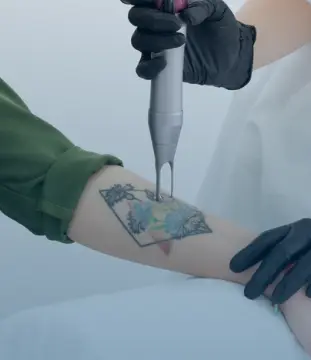Laser Tattoo Removal vs Other Methods

Tattoos have become a cherished art form, a personal expression etched permanently on the skin. Yet, as life evolves, so too do our wants and needs. Perhaps a once-loved design no longer fits who you are, or you’re looking to lighten a tattoo to make space for new ink. Whatever the reason, the question arises—what is the best way to remove a tattoo?
Today, various tattoo removal methods exist, but not all are created equal. This blog aims to explore and compare these methods, with a focus on laser tattoo removal, particularly PicoWay technology, which is revolutionizing the industry. By the end, you’ll be armed with the knowledge to make an informed decision that suits your goals.
What Are Your Tattoo Removal Options?
Tattoo removal is no longer a one-size-fits-all endeavor. There are several approaches to consider, with each offering unique benefits and drawbacks. Let’s break them down.
1. Laser Tattoo Removal
Laser tattoo removal is the gold standard in the industry–and for good reason. At its core, this method uses laser technology to break down tattoo pigments into tiny particles, which the body’s immune system then naturally eliminates.
How It Works
The laser emits pulses of highly concentrated light energy. Each pulse targets specific tattoo pigments based on its wavelength. For instance, PicoWay, a leading laser technology used by Laser Eraser, is particularly effective due to its Pico-second pulse duration. This method delivers energy so quickly that the ink is shattered without causing excessive damage to the surrounding skin.
Pros
- Effective on All Colors: Lasers like PicoWay can treat complex, multi-colored tattoos effectively, including notoriously difficult shades like greens and blues.
- Precise: The laser targets the pigment without heavily impacting surrounding tissue.
- Minimal Downtime: Most sessions are quick, and patients can resume normal activities shortly after.
Cons
- Does Tattoo Removal Hurt? Pain is subjective, but laser removal is often described as feeling like a rubber band snapping on the skin. Topical anesthetics can minimize discomfort.
- Multiple Sessions Required: Complete removal isn’t instantaneous and usually requires 6–12 sessions depending on the tattoo.
2. Dermabrasion
Dermabrasion involves physically sanding down the top layers of the skin to remove tattooed areas. It’s one of the older methods available today.
How It Works
A rotating device exfoliates the skin to effectively “sand off” the tattoo. The process is invasive and typically performed under local anesthetic.
Pros
- Cost-Effective (Initially): The upfront cost per session is generally lower than laser removal.
- Accessible: Widely available, particularly in regions where access to advanced laser technology may be limited.
Cons
- Painful and Lengthy Recovery: The process is known for being uncomfortable, with extended recovery times due to skin trauma.
- Scarring: Risk of permanent scars is significantly higher compared to laser methods.
- Limited Effectiveness: Works better on small, superficial tattoos and struggles with deeply etched or multi-colored designs.
3. Salabrasion
Salabrasion, one of the oldest tattoo removal techniques, relies on salt to scrub away the tattooed layers of skin. It’s rarely recommended by professionals today but remains an option for those seeking low-cost solutions.
How It Works
Salt water is applied to the skin, followed by an abrasive tool or cloth to physically rub off the tattooed area.
Pros
- Low-Cost: The process is inexpensive.
- DIY Accessibility: Some attempt this method at home (though strongly discouraged).
Cons
- High Risk of Infection: Rubbing the skin raw leaves it susceptible to bacterial infection.
- Painful and Not Professional-Grade Results.
- Scarring and Skin Damage.
4. Tattoo Removal Creams
Over-the-counter solutions like tattoo removal creams promise painless fading. While the allure is strong, the efficacy often leaves much to be desired.
How It Works
These creams contain chemicals designed to fade pigments over time by exfoliating or bleaching the skin.
Pros
- Pain-Free.
- No Clinic Visits Needed.
Cons
- Minimal Efficacy: Most fail to fade tattoos significantly, particularly darker ink colors.
- Skin Damage: Harsh chemicals can irritate the skin, often without offering meaningful results.
5. Surgical Excision
Though typically a last resort, surgical excision is an option. This involves surgically removing the tattooed skin and stitching the area closed.
How It Works
Your tattoo is cut out entirely under anesthesia. Naturally, the size of your tattoo determines whether this method is an option.
Pros
- Guaranteed Removal.
- Quick, One-Time Procedure.
Cons
- Highly Invasive and leaves a permanent scar.
- Not Feasible for Large Tattoos.
Why Laser Tattoo Removal With PicoWay Leads the Pack
Given the limitations of many removal options, why is PicoWay laser tattoo removal the best choice for most?
- Versatility
Unlike creams or dermabrasion, PicoWay works on all skin types and tattoo colors, eliminating the long-standing challenges posed by multi-colored tattoos.
- Precision Meets Safety
PicoWay’s ultra-fast pulses target pigment particles at a microscopic level, keeping surrounding skin intact. This leads to fewer side effects, such as scarring or discoloration.
- Time-Efficient Results
Although multiple sessions are required, PicoWay’s advanced technology speeds up the removal process compared to older laser models or manual methods.
- Minimal Pain
Concerned about discomfort? Laser Eraser provides numbing solutions for a virtually pain-free experience. The sensation can’t be completely eliminated but is generally tolerable.
- Trusted by Professionals
Reputable clinics like Laser Eraser trust PicoWay for its proven efficacy and customer satisfaction ratings.
Key Considerations When Choosing Tattoo Removal Methods
Whether you’re leaning toward laser tattoo removal or exploring other methods, consider these critical factors before making your decision.
1. Tattoo Characteristics
- Size and Placement impact removal difficulty.
- Ink Density & Color vary in how well they respond to removal.
2. Skin Type
Some methods may cause hyperpigmentation or scarring, particularly for darker skin tones.
3. Budget
While laser technology may be more costly upfront, its long-term effectiveness often makes it the more economical choice.
4. Goals
Are you looking for complete removal or simply lightening the design for a cover-up tattoo?
Tattoo Removal Myths Debunked
- “Tattoo removal creams work just like lasers.” Unfortunately, no cream currently offers results comparable to laser removal.
- “Tattoo removal is permanent after one session.” Even PicoWay requires multiple treatments for complete removal.
- “Laser tattoo removal always leaves scars.” Advanced options like PicoWay minimize scarring significantly, especially with skilled operators.
Is Laser Tattoo Removal Right for You?
Tattoos represent personal stories, and their removal deserves care and precision. After comparing all available options, laser tattoo removal stands out as the safest, most effective method, offering the best balance between results, safety, and recovery time.
At Laser Eraser, we help clients achieve their tattoo removal goals with state-of-the-art PicoWay technology. Whether you’re ready to start fresh with clear skin or want to pave the way for new ink, we’ve got you covered.
Curious about whether laser tattoo removal hurts, or about how many sessions you’ll need? Schedule a consultation with our experts today and begin your tattoo removal journey.

